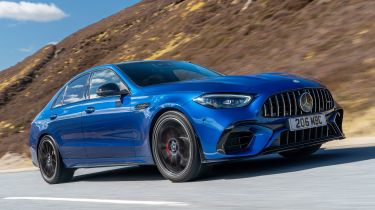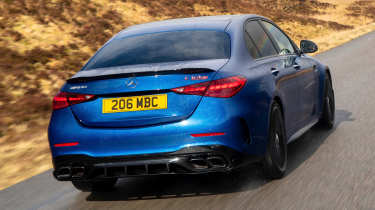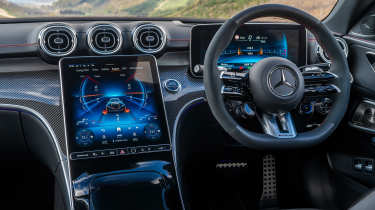Mercedes-AMG C 63 S E Performance 2024 review: plenty of power but not much fun
The new Mercedes-AMG C 63 S E Performance is let down by a lack of character from its plug-in hybrid powertrain

Verdict
The Mercedes-AMG C 63 S E Performance is an impressive performance car, with stunning speed, impressive control and huge levels of grip. But all of its tech feels like it’s there to fight problems created at its initial design stage, like its vast weight and four-cylinder plug-in hybrid powertrain. The main selling point of the previous C 63 is that while it lacked the sharpness of rivals from BMW or Alfa Romeo, it had them beaten for character, thanks largely to its engine. The new one has lost what made its predecessors so special.
It's a very clever car, the new Mercedes-AMG C 63 S E Performance. Perhaps more than with any previous hot Mercedes C-Class, Affalterbach’s engineers have overhauled almost every single aspect of the standard car to deliver supercar-baiting performance. But from behind the wheel, there’s always a nagging feeling that so much of that tech is there to fight against one or two fundamental issues.
We’ll focus on the chassis first. Dramatically flared front arches increase the width by 76mm, a necessary change to accommodate an increased track. Unique steering knuckles and suspension joints enable further precision, agility and stability, while an adaptive damping system, used on both the AMG GT Black Series and the brand’s GT3 racers, continuously adjusts the rate of control based on driving style and the condition of the road. Those dampers are significantly beefed up with twin external valves, allowing a greater and more precise transfer of hydraulic fluid than standard items.
Used - available now

2021 Mercedes
C Class
47,478 milesAutomaticPetrol1.5L
Cash £15,000
2019 Mercedes
C Class
72,827 milesAutomaticDiesel2.0L
Cash £16,187
2021 Mercedes
C Class
65,936 milesAutomaticDiesel2.0L
Cash £18,500
2021 Mercedes
C Class
31,252 milesAutomaticPetrol1.5L
Cash £15,900Rear axle steering turns up to 2.5 degrees in opposite directions to front wheels below 62mph, and up to 0.7 degrees in the same direction above that speed. The wheels measure 20 inches all round (but are wider at the back) and house brake discs gripped by six-piston fixed callipers at the front and one-piston floating callipers at the rear.
The key update for this new model comes from the powertrain, because the C 63 has gone plug-in hybrid. There’s no huge battery designed for long-distance EV driving here, though; instead, a compact 6.1kWh unit is designed to both deploy and recover energy as rapidly as possible to give a serious kick of electrical boost when you’re attacking a race track. The 89kg pack is linked to an e-motor that makes 201bhp and 320Nm, driving the rear wheels directly for improved response via an electronically controlled limited slip differential, but with the ability to send drive to the front if a loss of traction is detected.
If you do want to drive in e-mode, it still can; Mercedes claims 6.8 miles of range. For this PHEV system, then, think less Mercedes C 300 e and more Ferrari 296 GTB.
But while that Ferrari has a compact V6 that has much of the musical joy of the supercar marque’s larger engines, here Mercedes has traded the old car’s V8 twin turbo for an engine with half the cylinders.
Against the numbers, it’s incredibly effective. A pumped up version of the M139 fitted to the A 45 makes 469bhp at 6,725rpm and 540Nm between 5,250-5,500rpm. Those incredible numbers for a 2.0-litre unit make it the most powerful series production four-cylinder engine you can buy.
Throw in the full might of the hybrid system, and those figures climb to 671bhp and a staggering 1,020Nm. With all that power deployed to all four wheels – the old car was strictly rear-wheel drive – and the result is a 0-62mph time that’s a full half-a-second faster, now at 3.4 seconds.
On the road, there’s no getting away from the fact that one thing is missing from the old car: character. Prod the starter button and you’re greeted not by a snarling V8, but by silence. That’s not necessarily a bad thing; it means those early starts no longer wake up the neighbours, and in a way it heightens the anticipation for that engine barking into life all the more.
But when that engine wakes up, there’s no bassy burble, but a distant four-cylinder turbo drone. Slip behind the wheel for the first time expecting the theatre of older V8 AMGs, and the driver’s despondent sigh and drop of the shoulders happens on instinct.
It’s certainly fast. The torque of the electric motor gives superb initial throttle response, and that power builds all the way to the red line, pinning you back into your seat. Gearshifts from the nine-speed gearbox don’t always get the torque fill from the electric motor that you anticipate, though, causing a jolt as the next ratio is pulled. Once again we come back to the noise that accompanies it as the major downside; while it’s suitably angry for a four-cylinder, it doesn’t feel right in a sports saloon.
The chassis is more convincing. The balance front to rear is superb, steering is wonderful in both its precision and weight, and grip and traction are stunning. The body control is impressive, too, with large bumps and compressions doing little to upset the car’s balance unless you’re really loaded up in the middle of a corner. But for all its strengths, there's always the lingering feeling that all of this tech is battling against any performance car's biggest enemy: weight.
And there's lots of it. The C 63 S tips the scales at 2,165kg – a chunky 410kg more than the old one. The PHEV powertrain isn’t solely to blame, because even a standard C 220 d weighs 210kg more than its predecessor, but wherever that mass comes from, all we’re left thinking is just how exciting this car could be with all of the latest tech applied to something a few hundred kilos lighter.
In isolation that ride is impressively controlled - and relaxed enough in Comfort mode (one of eight bewildering choices available) to be easy to live with every day - but an Alfa Romeo Giulia Quadrifoglio is more supple, and both the Alfa and the BMW M3 feel sharper and more agile when you want to drive keenly.
Elsewhere, there are other compromises brought about by that PHEV powertrain, or little benefit where you might expect more. The battery pack’s location above the rear axle compromises boot space, with just a pokey 279 litres of storage available. Fuel consumption is unremarkable, too; driven mildly enthusiastically on the road, fuel consumption dropped into the low twenties, with a longer run delivering around 30mpg.
Cabin is typical C-Class fare, so well finished but with extra lashings of carbon fibre around that huge central touchscreen. The seats are very supportive, and they can grip you just as tightly as you please thanks to adjustable side bolsters.
| Model: | Mercedes-AMG C 63 S E Performance |
| Price: | £97,530 |
| Powertrain: | 2.0-litre 4cyl turbo, PHEV |
| Power/torque: | 671bhp/1,020Nm |
| Transmission: | Nine-speed auto, four-wheel drive |
| 0-62mph: | 3.4 seconds |
| Top speed: | 174 mph |
| Economy: | 38.7mpg |
| Co2: | 167g/km |
| Size (L/W/H): | 4,842/1,900/1,458mm |
| On sale: | Now |










